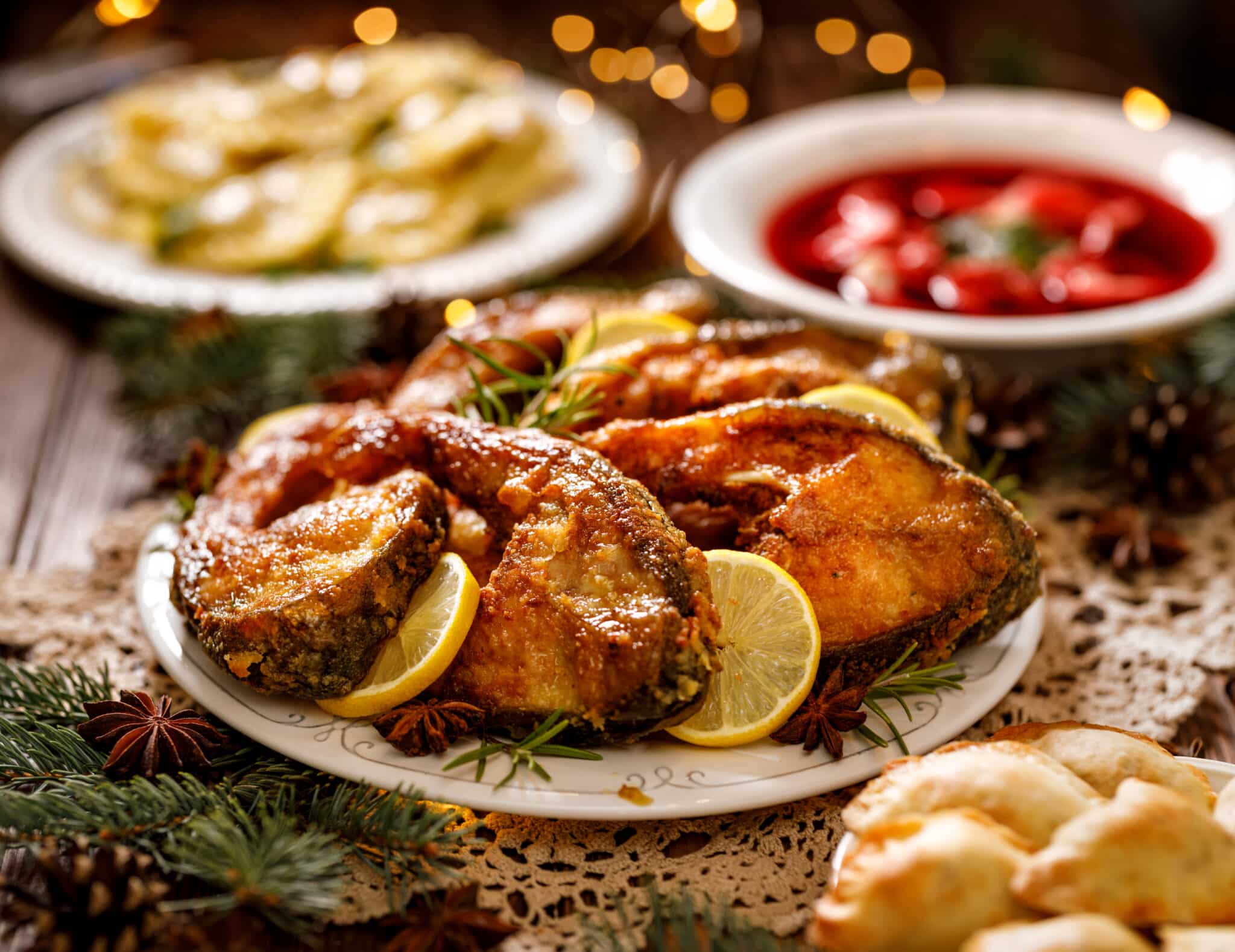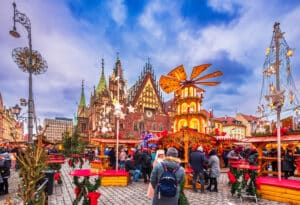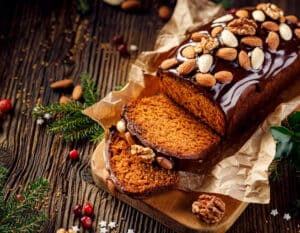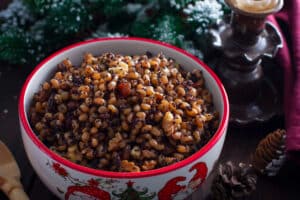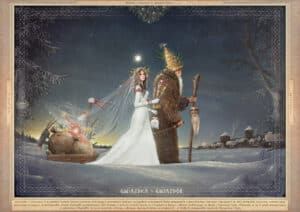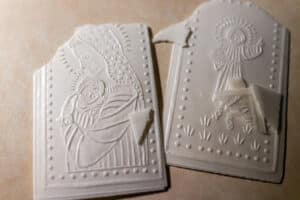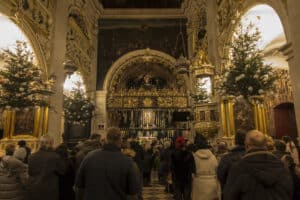By the end of November, the cold cobblestone streets in Polish villages and cities are lined with Christmas markets selling traditional Polish cuisine, handcrafted souvenirs, and traditional amber handicrafts. Christmas is one of Poland’s largest celebrations. The main festivities occur over the course of three days from December 24 to 26. The 25th and 26th are days off to celebrate and relax with friends and family.
Wigilia, Poland’s Christmas Eve celebration, is the most crucial element of the season. While not an official day off, most businesses, if open at all, will close by around noon so that employees will have time to prepare and celebrate. Represented in specific rituals, dishes, and activities, the holiday reflects Poland’s regional diversity, ancient pagan roots, and strong national and Catholic identity.
Pagan Background
Today 95% of Poles are Christian and 85% identify as Catholic. However, even though Poland was officially “baptized” Christian in 966 by Mieszko I, Slavic polytheism, the “native faith” or rodzimowierstwo, as it is known to Polish anthropologists, remained a significant religion in Poland until about the fifteenth century. With this slow adoption, the two faiths combined over time – pagan elements and imagery integrated with most Christian celebrations. This is best witnessed in celebrations of the solstices and equinoxes, which were particularly important to pagan belief. This can be seen both in current celebrations of the summer solstice, known as Wianki, and in the celebration of Christmas Eve, often referred to as Wigila, which occurs near the winter solstice. Almost all rituals associated with modern Wigila link celebrating the birth of Christ with imagery and practices that honour the dead, try to bring good luck and prosperity to the family, and honour nature for providing sustenance to generations of family members.
Preparation for Wigilia
Preparations for Wigilia are carried out with the belief that a joyous and bountiful Wigilia will portend a joyous and bountiful upcoming year. Families deep clean their homes before the event. Christmas trees are traditionally decorated with apples, nuts, straw stars, and cookies, all of which appear in pagan beliefs as associated with fortune and fertility.
The name Wigilia is derived from wieczerza – a word from old Polish that refers to formal evening dinner. The dinner cannot start until the first star appears in the sky. Representing the Star of Bethlehem, the children in the family are tasked with keeping watch for the star’s appearance and announcing it so that the meal can begin. The meal consists of twelve dishes, which recalls the twelve apostles as well as pagan associations with the twelve months of the year. All guests must try each of the twelve dishes to secure good luck and fortune for their new year and to show respect for their dinner host.
While setting the dinner table, a white tablecloth is used. White is viewed in nearly all western cultures as a color of purity and health. Hay or dried grass is placed under the tablecloth to remind the family of Jesus’s bed in the manger. It is also, according to Slavic superstition, a source of good luck and hay is sometimes even kept in the corners of the home throughout the year for the same reason. Lastly, the table is set with one extra place to be left empty in memory of family members passed or in case an unexpected guest should appear as it is believed no one should be left alone on this important day. Some families also leave the table laid throughout the night because it is believed that spirits of deceased family members can visit on this night and might want to partake of some of their favorite foods.
Traditional Wigilia Foods
Wigilia is considered a fasting day by the Catholic calendar and thus the twelve dishes are vegetarian and/or fish-based.
The meal is traditionally begun with the breaking of a Christmas wafer called an “oplatek” in Polish. This piece of unleavened flatbread is marked with religious imagery – often an image of the nativity. The eldest member of the family will begin the process by breaking off a piece for themselves before passing it on with a prayer for the family. This is done in imitation of Jesus during the Last Supper. The ritual sharing of bread also far predates Christianity and has long been used to unite a group around a single loaf while reminding the group of the importance of experience and leadership and the importance of only taking your fair share, so that all might be provided for. The wafer is rooted in pagan symbolism as it is believed to attract the spirits of loved ones. Before going to Midnight Mass after the meal, some families may even sprinkle crushed wafers on leftovers left on the table to offer and guide their ancestors to the meal.
Fish, mushrooms, and nuts, which all recall the bounty of Poland’s forests, dominate the Wigilia table. Potatoes and cabbage are also common ingredients used in many different ways as they have long been widely available in Poland to all socioeconomic classes. Meanwhile, the different ways families prepare their meal reflect various levels of Jewish, German, and Baltic influences and heritage.
For Polish families with Baltic roots, herring is popular dish, served with sour apples and onions. Soup, which often accompanies Slavic meals, is often represented, usually mushroom or barszcz – red beet-root soup. Pierogi, a dumpling and perhaps Poland’s most popular national dish, also adorn Wigilia tables, filled with potato, cabbage, and/or mushrooms. Other cabbage-based dishes include gołąbki – cabbage rolls that are often stuffed with rice, mushrooms, nuts, and/or buckwheat.
The most common centrepiece to Wigilia for all families is carp. Carp is thick, fatty, highly nutritious, and has few bones. It represents good luck and prosperity. Based on pagan superstitions, some families will even tuck the carp scales under their dinner plates or keep them in their wallet after the meal to attract wealth and good fortune for the new year.
Deserts are often dominated by poppy seeds. Introduced to Poland in the middle ages by Armenian merchants, these were once primarily associated with the upper class and prosperity. Today, they are common and it is often said that your coming year will be as prosperous as the number of poppy seeds used on your Wigalia deserts. These sweeter dishes include makowiec, a poppyseed cake, and kutia, porridge-like dish with fruits, different grains, nuts, and poppy-seeds soaked in red wine, is only prepared on Christmas Eve and is especially popular among Eastern Polish families. Some say that Mary was given kutia after giving birth to Jesus as a symbol of the new life and the new era she brought into the world.
Piernik, Polish gingerbread cake, is a common non-poppy-seed desert – but one that is rich in spices that were also once considered a delicacy and sign of wealth but now relatively common and still eaten as a symbol of prosperity.
Caroling on Wigilia
Carols are particularly important to Polish tradition. Today, there are more than a thousand of them and all tell of the events in Bethlehem the day that Jesus was born. Most Poles will include a carol sung as a family (or sung by children for the family) as part of their Wigilia dinner – before and/or after the meal.
First introduced to Poland in the early fifteenth century, carols quickly rose in popularity and became a staple in Polish households. This likely came, again, from the fact that the practice was able to merge with a long-standing pagan practice known as koleda, which was common among ancient Slavic cultures and involves dressing up in costumes and singing songs through the community to drive out bad energy, celebrate the arrival of good energy, or both.
Most of the carols currently sung by Poles were written in the seventeenth and eighteenth centuries. Carols would become an indelible part of Polish identity, particularly after the partitions of Poland wiped the Polish homeland from the map. Under their new rulers, Poles looked for ways to continue to express their unique linguistic heritage (none of the occupiers spoke Polish as a native language) and religious faith (while the Hapsburgs were Catholic, the other two occupiers were not – the Russian tsars were Orthodox while the Prussians were Protestants). Carols thus came to express the Poles’ enduring desire for independence.
One carol in particular became the flagship of this effort. Bóg Się Rodzi (God is Born) was written by the poet Franciszek Karpiński in 1792, between the second and third partitions. The song contains a line “raise your hand Jesus Child, Bless this great land” and is written in the style of a Polonaise, a Polish national dance. The song became a subversive anthem and prayer asking for the Polish homeland to be blessed and restored. It remains Poland’s most commonly sung carol. To browse other popular and important Polish Christmas carols, see this resource from the BBC with descriptions and recordings to listen to.
Carolling is sometimes carried outside the house, especially in more rural areas of Poland, in something that often still resembles koleda. The carolling season lasts until Three Kings Day in January. It is seen as a way of creating mutual prosperity for the community. This is conveyed from the carollers to the households they visit by conveying a blessing to them through the power of song. The households symbolically return the blessing by offering the carollers sweet foods and drinks.
Presents for Wigilia
Most Poles open presents after dinner and before going to mass. Although Santa is now the most popular personage for bringing presents, this has not always been the case. In fact, when Coca Cola used its famous Santa campaign in Poland in the 1990s, it caused considerable confusion for Polish children, who were used to St. Nick bringing presents only on his Dec 6 saint’s day. For Christmas the gift giver had usually been either the baby Jesus or a character named Gwiazdor (Star Man) and/or his female counterpart Gwiazdka (Little Star).
All of these personages are shared with German culture. Gwiazdor and Gwiazdka are pagan characters that come on the winter solstice to judge your actions for the past year. Most folklore studies cite them as being consistant with depictions of Marzanng and Nyig, who came to carry souls to the afterlife. It is thought that Gwiazdor and Gwiazdka evolved from these personages after the arrival of Christianity. While there are several variations on the characters, the most traditional has Gwiazdor wearing a wooden mask and a flowing costume made of straw. As this can be somewhat frightening and complex to fashion, many modern versions have him dressed in white or brown fur and a hat and boots that have been traditionally worn in rural areas. Gwiazdka is usually veiled, dressed in long white dress often decorated with flowers. They come with small presents for the good and a birch switch for the bad.
Mignight Mass
Although the mass is intended to be held at Midnight, in practice it is held in multiple sessions. Because it is so well attended, all of the faithful would not fit in the available facilities at one time. To make it maximally convenient, special family mass sessions are held earlier in the evening so that young children do not have to stay up so late. The mass lasts about 60-90 minutes and involves a considerable number of carols sung by the congregation.
You can read about how an SRAS student experienced Pasterka in Warsaw in 2020 with this article.
Celebrating the mass is also a strong aspect of Polish identity – as shown in the legendary mass held in the woods near the town of Zamość, not far from Warsaw, in 1942. Although the Germans had taken control and official banned the mass, resistance fighters arranged for a mass to be held in secret for about 500 attendees. In addition to carols, the mass ended with “God Save Poland,” the Polish national anthem of the time.
Also at midnight, children sometimes attempt to converse with their pets and animals as it is believed that the animals at the nativity were given the ability to speak in order to welcome Jesus into the world.
Wigilia Around the World
Polish diasporas throughout the Partitions of Poland, both World Wars, and Poland’s two-century fight for independence have maintained religious and cultural traditions overseas. One of the most prominent Polish communities abroad resides in Britain. It is common in cities such as London, Manchester, and Birmingham to find Polish Catholic churches, grocery stores, cultural organizations, and Polish Saturday schools that promote, and organize communal Polish celebrations. Most Polish families maintain the tradition of celebrating Wigilia. Mixed British-Polish families will often honour both cultures by celebrating Wigilia on the 24th of December and enjoying a traditional British Christmas on the 25th. Mushy peas just might accompany the Christmas carp in such mixed households.
Thus, Polish Christmas traditions across the globe combine Poland’s pagan past with their strong Catholic beliefs, diverse heritage, and the crucial importance of the family unit as the centre for good will, fortune, and blessings for the New Year.
You’ll Also Love

Milk Bars: Warsaw’s Proletarian Food Culture
This is a quick introduction to Warsaw’s milk bars, which are important cultural institutions as well as great places to eat, and to the Polish food they offer and the Polish language needed to order in them. While English-speaking eating establishments can be found, they will typically be more expensive and less of an important […]
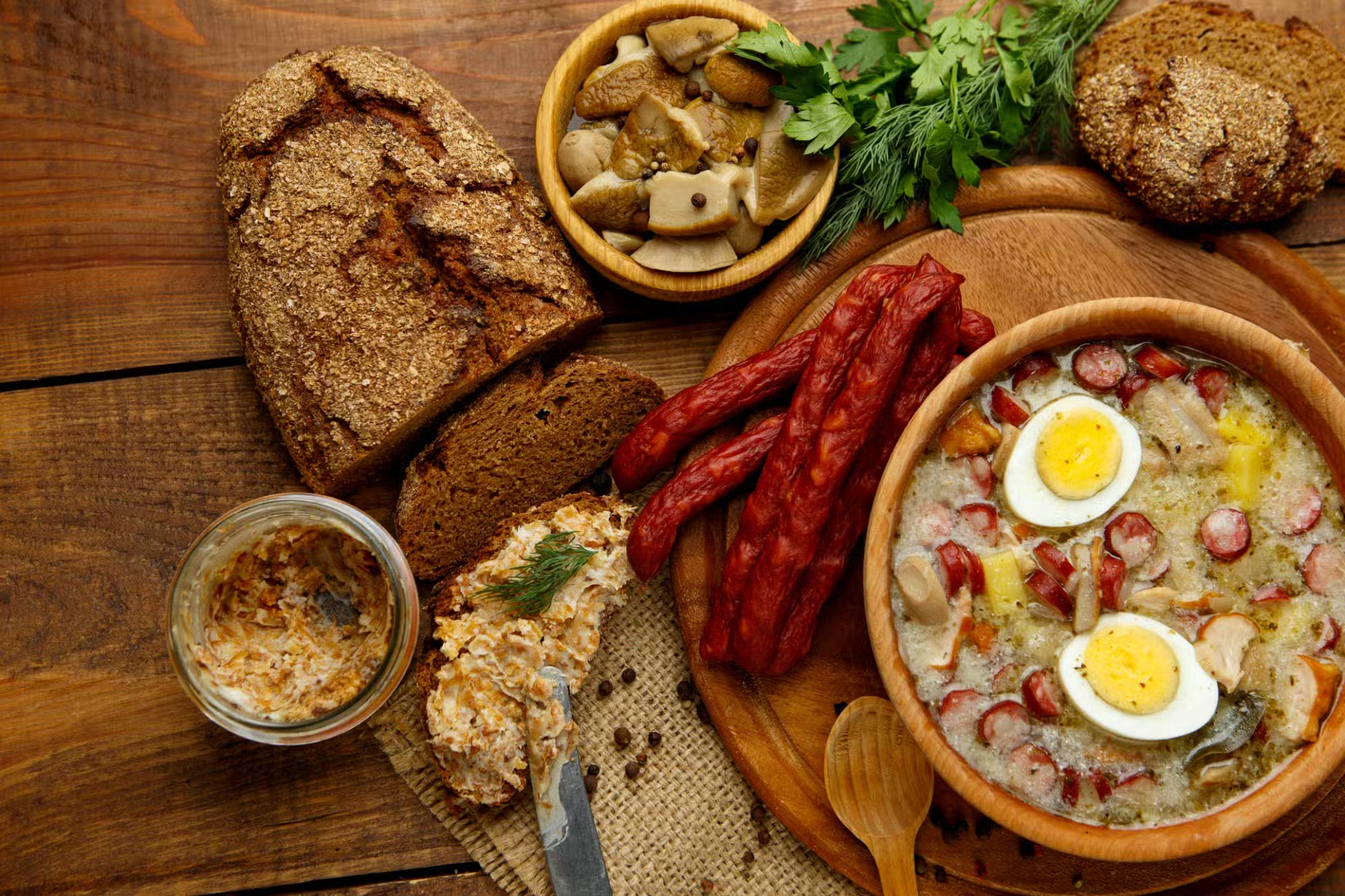
Dictionary of Polish Food
Polish food is hearty, flavorful, and deeply rooted in tradition. It is also experiencing a revival, re-inventing itself in major Polish cities as the country celebrates its heritage and embraces the latest trends and inspirations from world cuisines. Today, while dishes like pierogi, kielbasa, and bigos (hunter’s stew) are one you must try while visiting […]
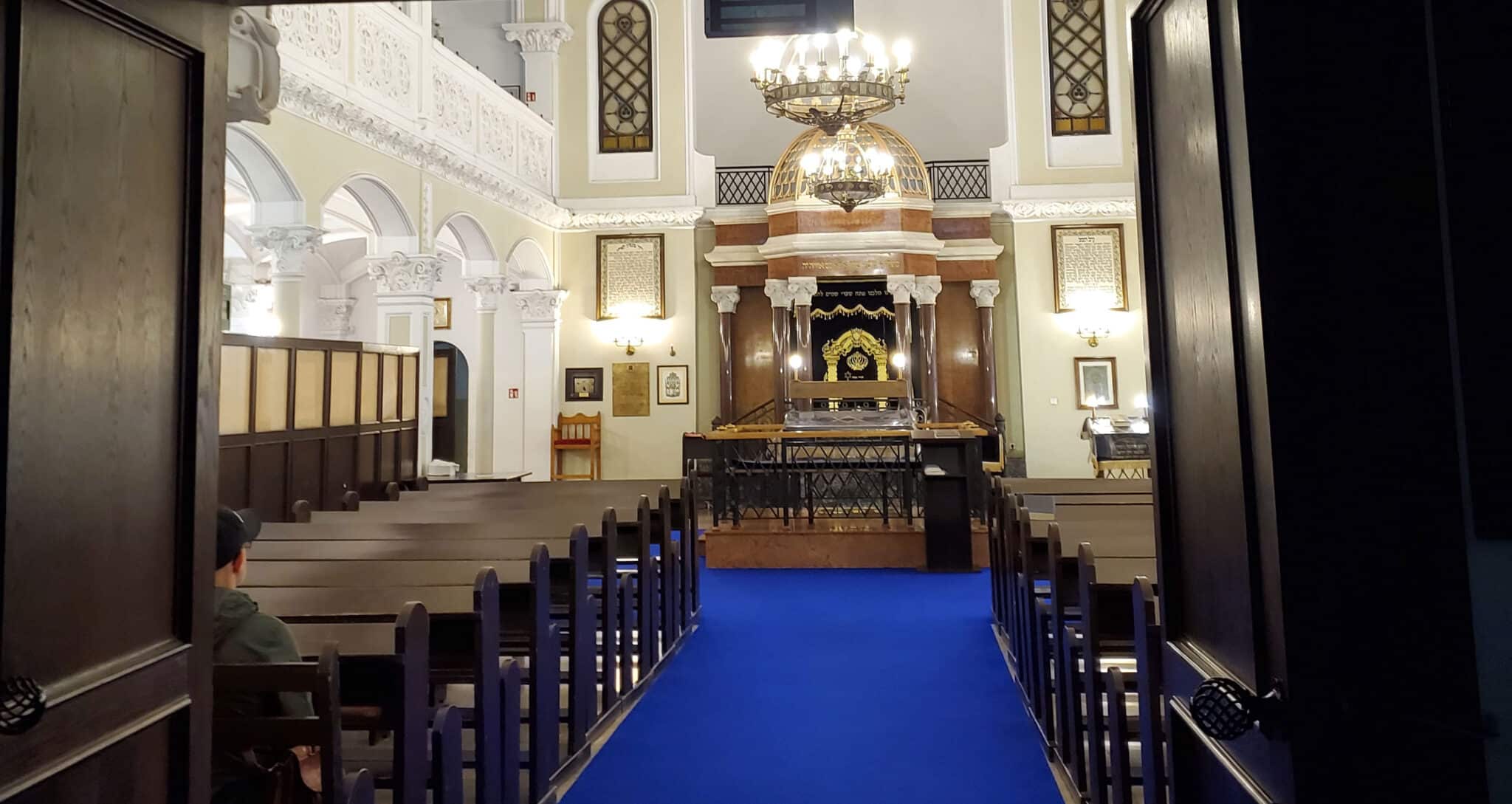
A Visit to Nożyk Synagogue in Warsaw
Tucked away on a side street in central Warsaw, the heart of the city’s old Jewish center still beats within the walls of the Nożyk Synagogue. The Nożyk Synagogue was the only synagogue in Warsaw to survive the devastation of WWII. Today, it serves as the primary place of worship for the Jewish community in […]

Pączki domowe: Polish Fat Thursday Donuts
“Pączki domowe” (pronounced pOHNch-kee, the singular form being pączek) are pastries similar to donuts. They are considered traditionally Polish, although they are enjoyed across Europe, in many places in North America, and beyond. They are deep-fried and filled with confiture or other sweet and/or creamy fillings, and are usually topped with a sweet icing, glaze, […]

Zupa Ogorkowa: Traditional Polish Pickle Soup
Polish pickle soup is similar to pickle-based soups that can be found across the Slavic world. In Russia, for instance, soups like solyanka and rassolnik are popular. Solyanka, however, prides itself on stuffing as much and as many kinds of meat into the soup as possible. Rassolnik is much more similar to Polish pickle soup […]

